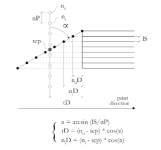piter
Member
Hello everyone,
I'm working on a project that involves controlling an array of nozzles within a CNC environment, where the nozzles travel along a linear path at a constant speed and a given angle. The objective is to activate all nozzles in unison along a line perpendicular to their direction of travel (see image). This control is achieved through G-code for movement commands and M functions for turning each nozzle on or off.

The core challenge I'm facing is achieving precise synchronisation between the nozzles' motion and their activation/deactivation, especially considering the inherent delay in the hardware's response time. The current setup has the nozzles travelling at a speed of 500 mm/s, with the system's PLC operating at a cycle time of 1 ms. This configuration limits the system's resolution to about 0.5 mm, which is tied directly to the PLC's cycle time.
Considering these constraints, I'm contemplating whether adopting a dedicated controller with a faster cycle time might be a viable solution.
I'd appreciate your insights on the following questions:
- Feasibility: Is using a dedicated controller with a faster cycle time a practical approach to enhance resolution in this scenario? Have any of you implemented a similar solution in your experience?
- Recommendations: If you recommend going with a dedicated controller, are there specific models or brands that align well with these requirements? Consider an array of 24 individual nozzles.
- Alternatives: Alternatively, are there other strategies or technologies you'd suggest exploring to address the synchronisation and resolution challenges without necessarily switching to a different controller?
I'm keen to hear your thoughts, experiences, and any advice you can share on optimising the performance of such a system.
Thank you in advance for your help and recommendations!
I'm working on a project that involves controlling an array of nozzles within a CNC environment, where the nozzles travel along a linear path at a constant speed and a given angle. The objective is to activate all nozzles in unison along a line perpendicular to their direction of travel (see image). This control is achieved through G-code for movement commands and M functions for turning each nozzle on or off.

The core challenge I'm facing is achieving precise synchronisation between the nozzles' motion and their activation/deactivation, especially considering the inherent delay in the hardware's response time. The current setup has the nozzles travelling at a speed of 500 mm/s, with the system's PLC operating at a cycle time of 1 ms. This configuration limits the system's resolution to about 0.5 mm, which is tied directly to the PLC's cycle time.
Considering these constraints, I'm contemplating whether adopting a dedicated controller with a faster cycle time might be a viable solution.
I'd appreciate your insights on the following questions:
- Feasibility: Is using a dedicated controller with a faster cycle time a practical approach to enhance resolution in this scenario? Have any of you implemented a similar solution in your experience?
- Recommendations: If you recommend going with a dedicated controller, are there specific models or brands that align well with these requirements? Consider an array of 24 individual nozzles.
- Alternatives: Alternatively, are there other strategies or technologies you'd suggest exploring to address the synchronisation and resolution challenges without necessarily switching to a different controller?
I'm keen to hear your thoughts, experiences, and any advice you can share on optimising the performance of such a system.
Thank you in advance for your help and recommendations!




